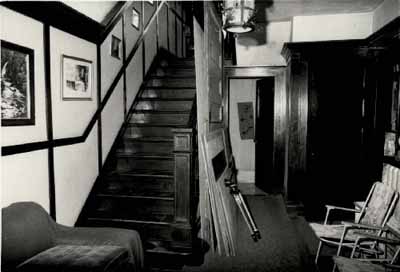Marconi Wireless Station National Historic Site of Canada
Glace Bay, Nova Scotia

Interior view
© Agence Parcs Canada / Parks Canada Agency, Aynsley MacFarlane.
Address :
Marconi Towers Road, Glace Bay, Nova Scotia
Recognition Statute:
Historic Sites and Monuments Act (R.S.C., 1985, c. H-4)
Designation Date:
1983-06-13
Dates:
-
1905 to 1907
(Construction)
Event, Person, Organization:
-
First regular public intercontinental wireless service
(Event)
-
Guglielmo Marconi
(Person)
Other Name(s):
-
Marconi Wireless Station
(Designation Name)
-
Marconi Towers
(Other Name)
-
Wireless Telegraphy Station
(Other Name)
-
Radiotelegraphy Station
(Other Name)
Research Report Number:
1984-027; 1983-007; 1983-008
Plaque(s)
Existing plaque: 14 McKeen Street, Glace Bay, Nova Scotia
Having demonstrated the feasibility of transatlantic wireless communication in 1901, Guglielmo Marconi established a permanent station on Cape Breton Island in 1902. When the original Table Head site proved too restricted, the station was relocated in 1905 to Marconi Towers, south of Glace Bay. This new station, operating with a “sister” in Clifden, Ireland, first provided regular public intercontinental service in 1908, and here Marconi further refined wireless technology. VAS, the Voice of the Atlantic Seaboard, began broadcasting from there in 1922. The station closed in 1946.
Description of Historic Place
The Marconi Wireless Station National Historic Site of Canada is located on Nova Scotia’s rugged northeast coastline, between Glace Bay and Port Morien, in Cape Breton Regional Municipality. Consisting of 350 hectares (800 acres) of mostly barren headland, the site was the location of the first regular intercontinental wireless communications service. Official recognition refers to the 350-hectare site, including associated structures that include the foundations of aerial towers as well as three abandoned buildings in varying degrees of repair.
Heritage Value
Marconi Wireless Station was designated a national historic site of Canada in 1983 because: it provided the first regular intercontinental service in 1908; and it is the site where Marconi further refined wireless technology.
Marconi Wireless Station, operating with a “sister” station in Clifden, Ireland, was the first to provide regular public intercontinental service in 1908. Built between 1905 and 1907, it became the main transmitting station and the site where Marconi further refined wireless technology.
The site provided an alternative to the first permanent station, which proved too restricted. The original site was established in 1902 at Table Head, on Cape Breton Island, by Guglielmo Marconi after the feasibility of transatlantic wireless communication was demonstrated in 1901. Located further south, between Glace Bay and Port Morien, the Marconi Wireless Station ceased operations in 1946.
Source: Historic Sites and Monuments Board of Canada, Minutes, June, 1983.
Character-Defining Elements
The key elements that contribute to the heritage character of this site include: the location on the eastern tip of Nova Scotia facing Big Glace Bay Lake; the large 350-hectare surface area, with structures and remains on an open site; the integrity of the foundations of the aerial towers, in their footprints and original materials; the varied massing, heights, sizes and distinctive profiles of the site’s surviving structures, including the three-storey main station building, the two-and-a-half-storey residence, and the coach house; evidence of interior layouts and finishes of the buildings associated with the Marconi Wireless Station’s functions, including remaining operational equipment; the spatial relationship of the buildings to each other, to the foundations of the aerial towers, and to the open site.